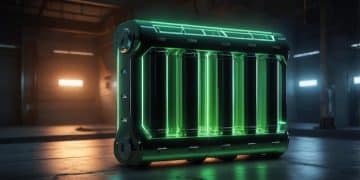US Energy Future: How the Energy Mix Will Evolve in 25 Years

In the next 25 years, the US energy mix is projected to shift significantly towards renewable sources like solar and wind, driven by climate targets and technological advancements, while also facing challenges from grid modernization and energy storage.
The quest for a sustainable future is driving a dramatic transformation of the US energy landscape. But how will the US energy mix evolve over the next 25 years to meet climate targets? Shifting away from fossil fuels and moving toward renewable resources presents both opportunities and challenges.
Renewable Energy Surge: Solar and Wind Power
Solar and wind energy are poised to dominate the US energy mix in the coming decades. Technological advancements and decreasing costs are making these renewable sources increasingly competitive with traditional fossil fuels.
The Growth of Solar Energy
Solar energy is experiencing exponential growth due to its versatility and scalability. Innovations in photovoltaic (PV) technology are boosting efficiency and reducing manufacturing costs, making solar panels more accessible to homeowners and businesses.
Wind Power Expansion
Wind power is also expanding rapidly, particularly in the Midwest and Great Plains regions. Larger and more efficient wind turbines are capturing more energy, leading to increased electricity generation from wind farms.
- Government incentives, such as tax credits, are driving investment in renewable energy projects.
- Improved energy storage solutions are addressing the intermittency challenges of solar and wind power.
- Grid modernization efforts are crucial for integrating renewable energy into the existing infrastructure.
The transition to solar and wind power requires overcoming challenges related to intermittency, energy storage, and grid infrastructure. However, the potential benefits, including reduced carbon emissions and a more resilient energy system, are significant.

The Role of Natural Gas in the Transition
Natural gas is expected to play a significant role in the US energy mix as a bridge fuel during the transition to renewable energy. Its lower carbon intensity compared to coal makes it a cleaner alternative for electricity generation.
Natural Gas as a Bridge Fuel
Natural gas power plants can provide a reliable source of electricity to complement intermittent renewable energy sources. They can quickly ramp up or down to meet changes in demand and ensure grid stability.
Challenges and Concerns
Despite its benefits, the use of natural gas faces environmental concerns, including methane leakage during production and transportation. Efforts to reduce methane emissions are crucial for minimizing the climate impact of natural gas.
The long-term role of natural gas in the energy mix depends on advancements in carbon capture and storage technologies. If these technologies can be successfully deployed, natural gas could remain a viable option for electricity generation while minimizing carbon emissions.
Nuclear Energy: A Consistent Source
Nuclear energy currently supplies a significant portion of the US electricity needs and is under consideration for a role in future zero-carbon strategies. Its reliability and high energy density make it an attractive option for baseload power.
Current Nuclear Capacity
Existing nuclear power plants provide a stable and consistent source of electricity, operating around the clock with minimal carbon emissions. Extending the lifespan of these plants is essential for maintaining a diverse energy mix.
Advanced Nuclear Technologies
New nuclear technologies, such as small modular reactors (SMRs), are being developed to enhance safety, reduce costs, and improve flexibility. SMRs can be deployed in smaller grids and offer greater scalability.
- Nuclear energy offers a dependable source of power, reducing reliance on fossil fuels.
- Public perception and waste disposal remain significant challenges for nuclear energy.
- Government support and regulatory frameworks are vital for the development and deployment of advanced nuclear technologies.
The future of nuclear energy in the US energy mix depends on overcoming public perception challenges and addressing concerns about waste disposal. However, its potential as a reliable and zero-carbon energy source makes it a valuable option for meeting climate targets.
Electric Vehicle Adoption and its Impact
The growing adoption of electric vehicles (EVs) will have a profound impact on the US energy mix. As more consumers switch to EVs, the demand for electricity will increase, requiring adjustments in the generation and distribution of power.
Increasing EV Adoption
Electric vehicles are becoming more affordable and accessible, driven by technological advancements and government incentives. Automakers are investing heavily in EV production, leading to a wider range of models and options for consumers.
Impact on Electricity Demand
The widespread adoption of EVs will significantly increase electricity demand, requiring investments in new generation capacity and grid infrastructure. Smart charging technologies can help manage the increased demand and optimize grid performance.
The integration of EVs into the energy system presents both challenges and opportunities. By leveraging renewable energy sources to power EVs, the US can further reduce carbon emissions and create a more sustainable transportation system.

Energy Storage Solutions: Batteries and Beyond
Energy storage is a critical component of the future US energy mix. It addresses the intermittency challenges of renewable energy sources and enhances grid reliability.
Battery Technology
Battery storage systems are becoming more affordable and efficient, enabling the storage of excess electricity generated from solar and wind power. These systems can be deployed at utility-scale or at residential-scale, providing flexibility and resilience to the grid.
Alternative Storage Solutions
In addition to batteries, other energy storage technologies are being developed, including pumped hydro storage and compressed air energy storage. These technologies offer large-scale storage solutions for balancing the grid and ensuring a reliable power supply.
- Energy storage enhances grid stability and reliability by providing backup power during outages.
- Advanced storage technologies are crucial for integrating variable renewable energy sources into the grid.
- Investments in energy storage are essential for a sustainable and resilient energy system.
Energy storage solutions are essential for enabling a greater integration of renewable energy into the US energy mix. By addressing the intermittency challenges of solar and wind power, energy storage technologies enhance grid reliability and resilience.
Policy and Investment Driving the Change
Government policies and investments play a crucial role in shaping the future US energy mix. Incentives, regulations, and research funding can accelerate the transition to renewable energy and promote energy efficiency.
Federal and State Policies
Federal policies, such as tax credits and renewable portfolio standards, are driving investment in renewable energy projects. State policies, such as energy efficiency standards and carbon pricing mechanisms, are also contributing to the transition.
Infrastructure Investments
Investments in grid modernization and energy storage are essential for integrating renewable energy into the existing infrastructure. Upgrading transmission lines and deploying smart grid technologies can enhance grid reliability and efficiency.
Policy and investment decisions will determine the pace and direction of the US energy transition. By creating a supportive regulatory environment and allocating resources to key technologies, the government can accelerate the shift to a cleaner and more sustainable energy system.
| Key Point | Brief Description |
|---|---|
| ☀️ Solar Energy Growth | Rapid expansion of solar energy due to lower costs and improved technology. |
| 💨 Wind Power Expansion | Increased wind power capacity, especially in the Midwest and Great Plains. |
| 🔋 Energy Storage Crucial | Batteries and other storage solutions are vital for grid stability. |
| ⚡ EV Impact | Electric vehicle adoption drives electricity demand and affects energy mix. |
FAQ
▼
The primary renewable sources are solar and wind energy, but geothermal, biomass, and hydropower also contribute to varying degrees.
▼
Natural gas is expected to serve as a “bridge fuel,” providing a cleaner alternative to coal while renewable infrastructure expands.
▼
Nuclear energy could maintain its role as a baseload power source, especially with the development of new reactor technologies.
▼
EV use increases electricity demand, pushing for more renewable energy generation to avoid increasing emissions overall.
▼
Energy storage solutions help balance the intermittent nature of renewable sources like solar and wind, ensuring a reliable power supply.
Conclusion
The US energy mix is on the cusp of a significant transformation, driven by the urgent need to address climate change. While challenges remain, the convergence of technological advancements, supportive policies, and increasing investment is paving the way for a cleaner, more sustainable, and resilient energy future.





